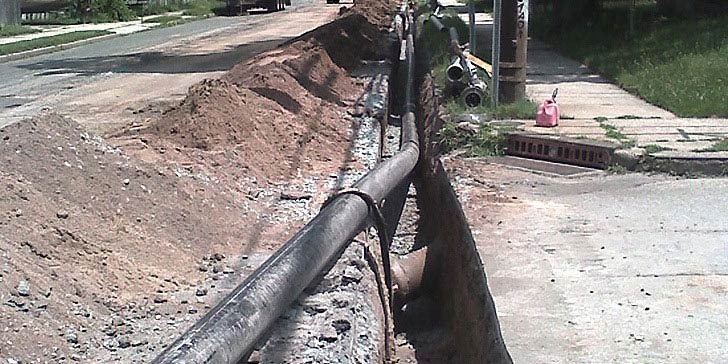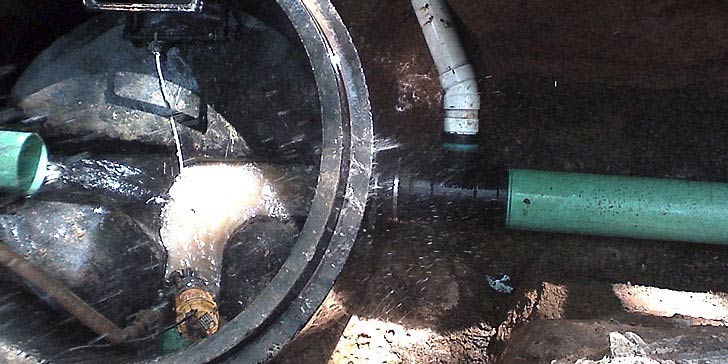New Jerseys Sewer Repair Headquarters
ICUNJ is a sewer repair contractor in NJ who has led the industry in implementing innovative solutions for trenchless sewer line repair, and trenchless sewer replacement. No two sewer repairs, sewer backups, or sewer line replacements are the same, so our dedicated team of industry experts work with you to develop customized solutions to meet the most challenging conditions.
We Offer Free Video Inspections!
Interested in construction?
Come and check out our latest articles!
Click Here
Positive Pitch
 Positive pitch on sanitary sewer pipe is required to properly transport both solid and liquid waste. Exaggerated (too much) pitch causes liquids to travel quickly while leaving solids behind to congest the line. Not enough pitch also results in solids congesting the line. Proper pitch is normally considered ¼" drop for every foot horizontal (check with your local plumbing official for acceptable tolerances).
Positive pitch on sanitary sewer pipe is required to properly transport both solid and liquid waste. Exaggerated (too much) pitch causes liquids to travel quickly while leaving solids behind to congest the line. Not enough pitch also results in solids congesting the line. Proper pitch is normally considered ¼" drop for every foot horizontal (check with your local plumbing official for acceptable tolerances).
Root Intrusion


Roots are a very common problem for sewer lines constructed prior to the early 1980's. This is because these sewer lines were built using VCT (vitreous clay tile) pipe. Clay tile pipe is a ceramic product dating back to the Roman aqueducts and is an ideal material for transporting water since it is inert. Clay tile pipe is also an ideal material for use in difficult environments since it is amazingly strong, having nearly a 3/4" thickness, and is virtually impervious to deterioration from normal use. However, its multiple joints are a downside. Clay tile pipe tends to leak water at the joints, making a wonderful water source for thirsty trees and shrubs.
In the late 1800's, clay tile pipe in 2-foot lengths were the pipe of choice by plumbers constructing new sewer lines. These 2-foot lengths continued to be used until about 1930 when they were replaced by 3-foot or 4-foot lengths. These longer lengths continued to be used into the early 1980's when they were replaced by PVC or SDR plastic pipe and superior joint sealing systems. In addition, use of Asbestos Containing Pipe (ACP) or transite Pipe became popular in the late 30's and continued until the USEPA prohibited its use in 1978 because of its carcinogenic properties.
When originally installed, plumbers "sealed" the numerous joints in the clay tile sewer line with materials such as concrete, coal tar, oakum, or rubber gaskets. Unfortunately, all these sealing materials deteriorate over time, allowing water to escape, beginning an underground "drip system" attracting tree roots. Once tree roots get between the joints, they continue to grow, spreading the joint. As the joint spreads, it leaks more water. If tree roots are allowed to grow large enough, they will eventually break the clay tile pipe. Inside the clay tile pipe joint, tree roots initially act as a filter, allowing water to pass through while straining out other products sent through the line. As soon as the roots have trapped enough material, all water flow is stopped, resulting in sewage backup.
Sag or Belly

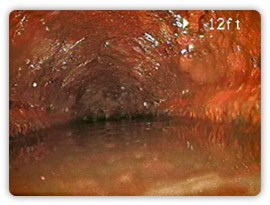
A Sag or Belly is where the sewer pipe has lost positive slope going to its destination. Typically, sewers flow by gravity to where they tie into the city's main sewer. If a line is properly installed, it will have a positive slope for the entire duration of its distance. Where a portion of the line has settled, the rate at which liquids travel through it is significantly reduced. The reduced velocity of liquids allows the area to collect solids, eventually obstructing the line.
Separations, Collapse & Cracks

 Separations, Collapse & Cracks in a sewer pipe can occur from a variety of sources, including poor original installation, poor soil bedding, root penetration or structural deterioration due to the age of the pipe. In addition to structural impacts, these conditions allow exfiltration of household waste and infiltration of clean groundwater into the wastewater sewer system.
Separations, Collapse & Cracks in a sewer pipe can occur from a variety of sources, including poor original installation, poor soil bedding, root penetration or structural deterioration due to the age of the pipe. In addition to structural impacts, these conditions allow exfiltration of household waste and infiltration of clean groundwater into the wastewater sewer system.
"Off-set" conditions occur when connected sections of pipe do not line up perfectly causing pipes to sits lower or off to the side of the connecting pipe.
Underground pipes are installed in sections or segments ranging from 2' to 20' or more. Sewer lines built from the 1800's up to the mid 1980's were constructed using a large number of short sections, typically 2' to 4' in length, of VCT (vitreous clay tile) pipe. These sewer lines are particularly subject to off-sets due to their large number of joints. During construction, the joints were sealed with products such as concrete, coal tar, oakum, rubber gaskets, and on occasion, nothing at all. Over time, these sealants erode away, allowing the pipe to then settle down. Offset joints can cause debris to build up on the joint that can eventually lead to backups. Also, if the joint is offset enough that soil is exposed around the edges of the pipes, the surrounding soil can erode into the pipe and be washed away, eventually causing voids to occur around the outside of the pipe and possibly become sink holes. Offset joints are not watertight and can allow infiltration of clean groundwater into the wastewater sewer system.
Debris / Grease
Debris / Grease debris can build up in a side sewer if there are structural defects or obstructions in the pipe (such as sags, roots or offset joints) that obstruct the flow of the sewer and if inappropriate items are flushed or poured down the drains. Or, if pipes are constructed at slopes less than the recommended ¼-inch drop per foot of pipe, the liquids won't be moving fast enough to carry away the solids in the pipe. If debris build up is severe enough, it can eventually fill a pipe and cause backups or slow-draining sewers. Examples of items that do not degrade like toilet paper and should not be flushed down a drain (even though they may be advertised as flushable) include baby wipes, disinfectant wipes, paper towels, egg shells, coffee grounds, dental floss, toilet bowl scrub pads, feminine hygiene products and grease. Even very hot grease cools quickly once it reaches an underground pipe and sticks to the walls of the sewer. Over time, grease can cause a sewer to either drain very slowly or cause a complete blockage of the side sewer. Grease is one of the more common causes of backups and slow-draining side sewers.
Methods to Eliminate Defects in Sewers
This section describes various methods available for repairing, replacing, or rehabilitating an existing sewer. Every sewer is unique and not all methods are suitable for all circumstances. It is always important to work with a sewer contractor experienced with the particular kind of construction to determine the suitability for each sewer on an individual basis and to obtain cost estimates for the various methods as they may vary greatly for each project.
Pipe Bursting:
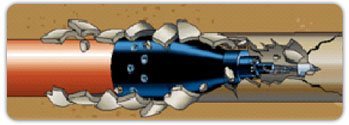 Pipe bursting is a method of replacing buried pipelines (such as sewer, water, or natural gas) without the need for a traditional open cut trenching. One or more pits are required to launch and receive the new pipe. Pipe bursting may also be used to expand pipeline carrying capacity by replacing smaller pipes with larger ones, or "upsizing." Extensive proving work by the gas and water industries has demonstrated the feasibility of upsizing sewer, gas and water mains and laterals.
Pipe bursting is a method of replacing buried pipelines (such as sewer, water, or natural gas) without the need for a traditional open cut trenching. One or more pits are required to launch and receive the new pipe. Pipe bursting may also be used to expand pipeline carrying capacity by replacing smaller pipes with larger ones, or "upsizing." Extensive proving work by the gas and water industries has demonstrated the feasibility of upsizing sewer, gas and water mains and laterals.
An expanding device called an expander head, which may be either pneumatic or hydraulic is introduced into the defective pipeline through a launching pit. As it travels through the pipeline toward the receiving pit it breaks the pipe into many small pieces, pushing the pieces into the surrounding soil. New pipe is attached to the back of the expander head and is pulled simultaneously with the expander head until it reached the receiving pit. Both ends of the new pipe are connected to their respective existing pipe to close the system and service is restored.
A Hydraulic puller is set into a receiving pit at one end of the existing pipe to be replaced. A heavy cable is attached to an expander head on the other end of the line to be replaced. The cable is then fed through the existing pipe and attached to the hydraulic puller. The hydraulic puller then pulls the expander head with the new pipe attached to it through the existing line, introducing the new line simultaneously.
Advantages: Pipes of all types and sizes follow paths through buildings, under driveways, sidewalks, trees, bushes, lawns, road surfaces and many other costly improvements. Since the bursting method is performed underground and through the existing line to be replaced, costly surface improvements are left undisturbed. Conditions such as offset joints, collapse, cracks, separations and roots are eliminated. The newly installed seamless pipe is impervious to roots and eliminates fluid migration between pipe the environment. Its smooth inner surface reduces the effects of friction which enhances pipe performance. Lateral repairs are typically performed in one day, while large mains take longer. Since pipe introduced using the Bursting method travels along the existing pipe alignment, if the existing pipe has a sag/belly, the new line will mirror the existing condition. The bursting techniques can be used in conjunction with a piercing tool to run a new line underground.
Disadvantages: Pipe introduced using the Bursting method travels along the existing pipe alignment. If the existing pipe has a sag/belly the new line will mirror the condition. ![]() Click here for additional information
Click here for additional information
Cured In Place Pipe (CIPP) lining:
A cured-in-place pipe (CIPP) is one of several trenchless rehabilitation methods used to repair existing pipelines. CIPP is a jointless, seamless, pipe-within-a-pipe with the capability to rehabilitate pipes ranging in diameter from 0.1–2.8 meter (4"–110"). As one of the most widely used rehabilitation methods CIPP has application in water, sewer, gas, and chemical pipelines.
A resin-saturated felt tube made of polyester is inverted or pulled into a damaged pipe. It is usually done from the upstream access point (manhole or excavation). It is possible to invert the liner upstream (e.g. from the downstream access point) but this carries greater risk. It is possible to install a liner from the downstream access point, upstream to a blind end however this carried the highest risk of all the CIPP installation methodologies. Little to no digging is involved in this trenchless process, making for a more environmentally friendly method than traditional "dig and replace" pipe repair methods. The liner can be inverted using water or air pressure. The pressure required for inversion can be generated using pressure vessels, scaffolds or a "Chip unit". Hot water, UV light, ambient cured or steam is used to cure the resin and form a tight-fitting, jointless and corrosion-resistant replacement pipe. Service laterals are restored internally with robotically controlled cutting devices. These can be sealed with additional seals into the lateral connection (Lateral Junction Repair). The rehabilitated pipe is then inspected by closed-circuit television (CCTV). CIPP is considered a trenchless technology.
Advantages: Typically, trenchless technology, CIPP does not require excavation to rehabilitate a pipeline that is either leaking or structurally unsound. Depending upon design considerations an excavation may be made, but the liner is often installed through a manhole, cleanout or other existing access point. Larger Diameter liners must be excavated in order to install. Liner is installed as it is wet out on site in these instances. In the case of sewer lines, lateral connections are also restored without excavation via a remote controlled device that drills a hole in the liner at the point of the lateral connection. CIPP has a smooth interior and no joints. While CIPP can repair a pipe with bends, special design considerations must be taken into account to prevent wrinkling and stretching. CIPP can effectively reduce infiltration and leaks in pipeline systems without digging.
Disadvantages: Except for very common sizes, liners are not usually stocked and must be made specifically for each project. CIPP requires bypass of the flow in the existing pipeline while the liner is being installed. The curing may take from five hours to 30 hours depending on pipe diameter and must be carefully monitored, inspected, and tested. Obstructions in the existing pipeline, such as protruding laterals, must be removed prior to installation. CIPP must also be carefully monitored for release of chemical agents utilized in the reaction process for contamination downstream of rehabilitated pipes. The liner material used for common sizes is normally a felted fabric (weave) and does not go around bends well without wrinkling and going out of round on corners. Liners used for pipes with bends (particularly 100 mm pipes) are made from a woven fabric allowing it to go around bends with minimal wrinkling. The more flexible the liner, the more care needs to be taken during inversion to ensure the liner remains on the correct alignment. All liners travel along the existing pipe alignment. If the existing pipe has a sag/belly, offset joint, collapsed section or other obstruction, the new liner will mirror the condition –lining is not recommended for pipe with these conditions. In addition, liners reduce the inside diameter of pipe which may affect pipe performance.
Open Cut Construction:
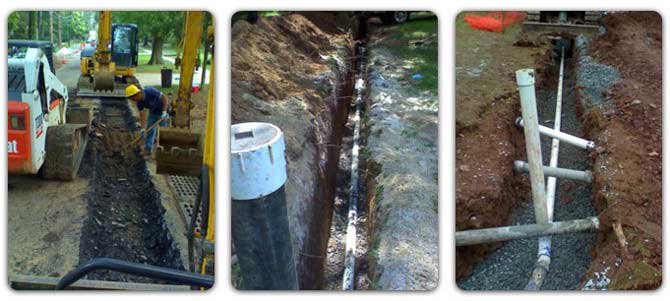
This method of construction is the typical dig and replace that most people are familiar with. This is the most common method of repairing side sewers and consists of digging up the old pipe and replacing it with new pipe. Open cut may be less suitable for areas where there are significant surface improvements that a property owner wants to avoid disturbing and that are costly to replace or when side sewers are fairly deep.
Spot Repairs:
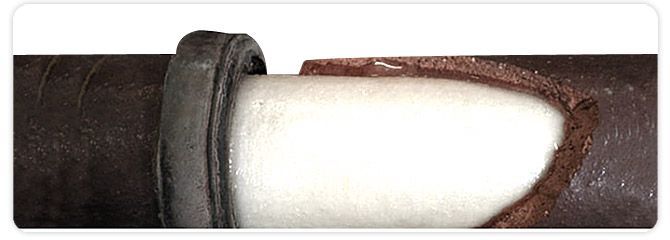
If the majority of a pipe is good condition with little or no defects, a spot repair may be the most suitable and cost effective method for repair. The property owner should consider a full sewer replacement or rehabilitation if there are multiple defects throughout the pipe. It is generally less costly to hire a contractor once than to have a contractor mobilize to a site multiple times with repeated spot repairs.
High Pressure Jetting:
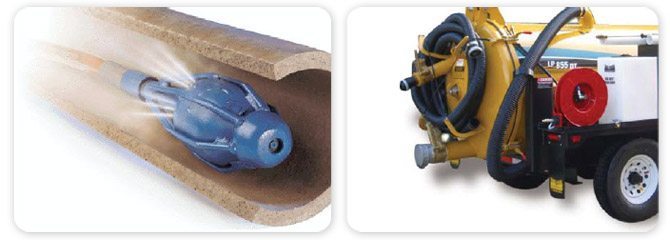
High Pressure Jetting to perform pipe cleaning is commonly performed by a technique known as sewer jetting. Sewer jetting is the application of streams of high pressure water for use within pipes for cleaning & debris removal. Water at the correct high pressure can cut roots, dissolve blockages, emulsify grease and soaps while spray washing pipe wall surfaces. As part of the jetting process, the water from the nozzle can also wash away accumulated dirt or debris on the bottom of the pipe at the same time.
For sewer jetting, a jetting nozzle is attached to the end of a length of high pressure hose with the other end connected to a high pressure water pump. Jetting nozzles have small precision machined orifices or jets to restrict water flow from the jetting pump thus causing high pressure to build within hose. As the pressurized water is expelled from the nozzle jets it reverts from pressure to velocity (speed) creating thrust that allows the nozzle to pull the jetting hose. With the system pressurized, high pressure jetting hose coiled on a hydraulic powered hose reel is released by the operator who controls the travel speed and distance of the nozzle up the pipe. Pressurized water expelled from the nozzle jets cleans debris, removes pipe blockages or roots from the inside of the pipe while traveling through the pipe. Optimum cleaning is achieved when the hose is being rewound onto the hydraulic reel. During this action, water from the nozzle jets effectively forms a curtain or wall of high pressure water that forces (or rakes) the debris downstream. Sewer jetting technology can be applied to clean all size pipe diameters with the appropriate size of high pressure jetting unit.
Snaking:
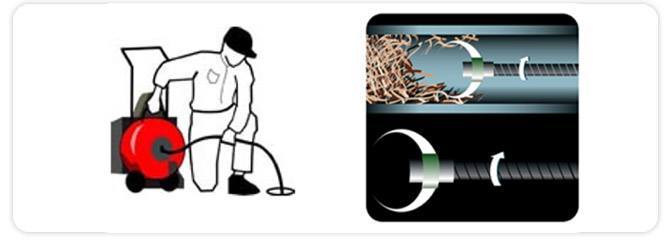 Snaking is more commonly performed to eliminate large objects accidentally introduced into a sewer system, non-biodegradable napkins, grease, oil or soap residue that collects on the pipe sidewalls, and roots. A drawback to this method is the damage that may occur in Plastic pipe, Orangeburg pipe and Deteriorated pipe regardless of composition. Snaking to eliminate roots is primarily a temporary solution and requires ongoing maintenance that may be frequent depending on how aggressive the vegetation is.
Snaking is more commonly performed to eliminate large objects accidentally introduced into a sewer system, non-biodegradable napkins, grease, oil or soap residue that collects on the pipe sidewalls, and roots. A drawback to this method is the damage that may occur in Plastic pipe, Orangeburg pipe and Deteriorated pipe regardless of composition. Snaking to eliminate roots is primarily a temporary solution and requires ongoing maintenance that may be frequent depending on how aggressive the vegetation is.
Most devices consist of a coiled metal wire with space between the coils at the end. The other end is attached to a device with a crank that rotates the wire as it moves down into the pipe. The auger end of the wire digs itself into the clog much like a corkscrew, allowing retrieval of the object causing the clog when the snake is pulled out. (Commonly hair, combs, small toys, cloth.) The end of the snake breaks up the object, allowing it to pass through the drain. (Commonly tree roots, foam insulation, plastic objects.) The snake flails around the inside surface of the pipe, scraping off accumulated matter (ranging from mineral deposits to bacon fat) which was reducing the effective interior diameter of the drain pipe.

